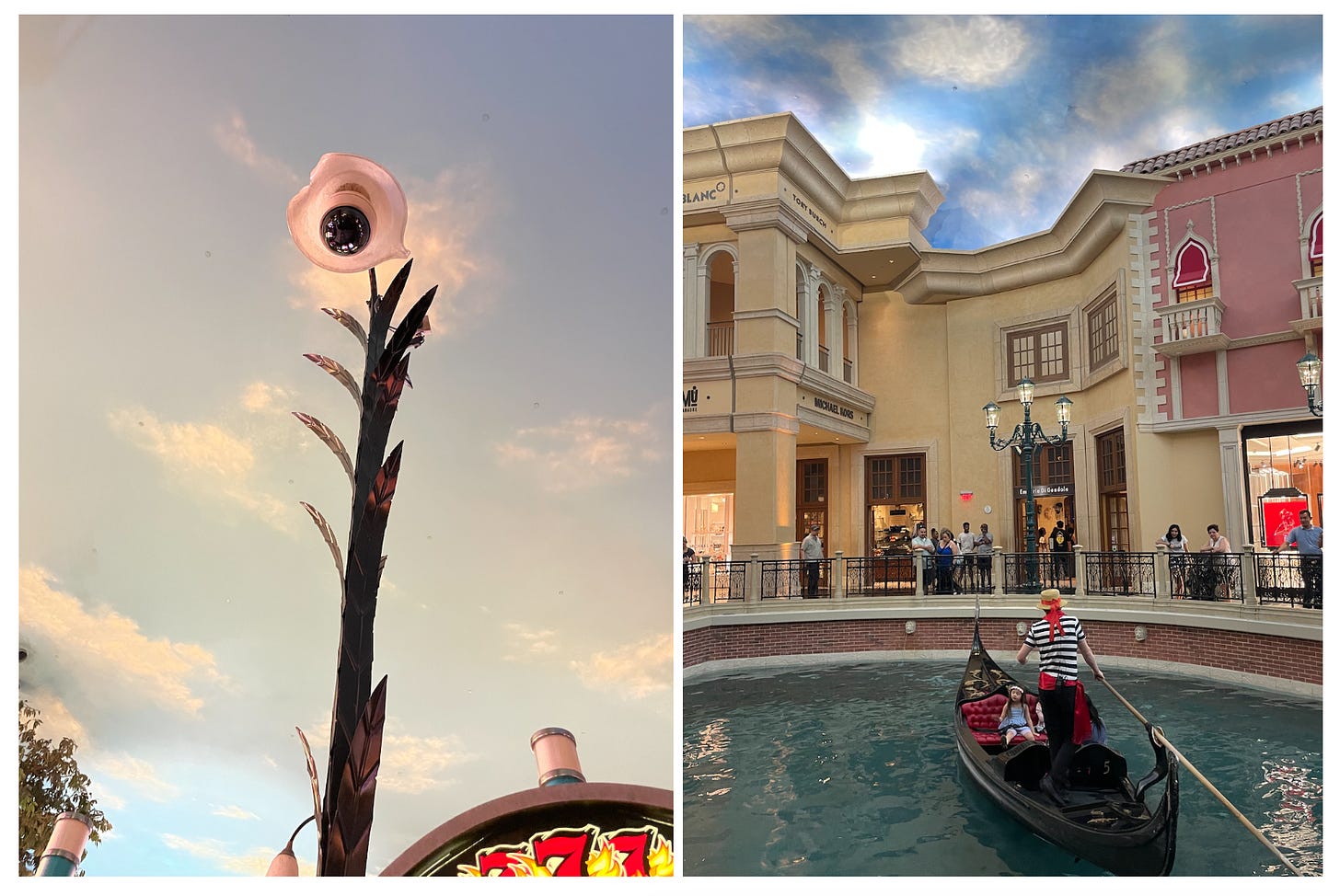I visited Las Vegas for a 36 hour trip, staying at the Platinum Hotel just off the strip. Walking in yellow toned glasses along the traffic of Flamingo Road towards Las Vegas Boulevard, dust blowing in the hazy sky, I was in a plastic beach ball, a world completely manufactured. From the concrete coating the wide streets and small sidewalks, to the sun-faded billboards and silver escalator cross walks, I could have been anywhere on any planet in any time. There is an absolute sense of abandonment of place, a simultaneous anxiety and thrill of being lost on a timeline between past and future, reality and fiction.
While I was in town, I revisited Robert Venturi and Denise Scott Brown’s Learning from Las Vegas, a seminal architecture criticism piece published in 1972. Venturi and Brown argue that Las Vegas’ sense of place arose from its embrace of entertainment, spectacle, and interplay of architectural elements rather than adhering to strict historical or regional contexts. The variety of symbols, signs, and ornamentation give it new tools of communication that attract and engage the public.
Learning from Las Vegas challenged conventional architectural thinking and encouraged a reevaluation of architectural values. It emphasized the importance of engaging with the public by embracing symbolism and understanding the significance of the vernacular in shaping meaningful and vibrant built environments. In contrast with the functionalist style that dominated architectural aesthetics for most of the 20th century, Las Vegas was crafted to relate to the individual. But that introduces the question: what is a meaningful environment?
Las Vegas speaks in the language of commercialism. From the proliferation of signs, billboards, and neon lights, visitors are constantly stimulated and engaged with their environment. There is no dull moment on the strip, the blending of styles and juxtaposing influence contributes to a visual collage. It is loud and alive, but not in an organic sense. Vegas is a celebration of money and carnal pleasures. It is intoxication, it is being stranded inside of something that traps you, tells you what you want.
Beyond the fulsome communication and symbolic usage in Las Vegas, there is also a lot of replication. Many casinos appropriated the design of well-known landmarks: the Eiffel Tower, the canals of Venice, ancient Greece in Caesars Palace, to name a few. This was intentional — using landmarks allows Vegas to tap into the familiarity and cultural associations people have with those places, which generates a sense of connection and recognition — leveraging their symbolic power to evoke emotions. By placing all these landmarks on the strip next to one another, Las Vegas also posits itself as a convenient and condensed place to vacation, providing experiences from around the world within the boundaries of one city, giving visitors the opportunity to immerse themselves in a variety of supposed cultural contexts. However, like the building fronts themselves, those experiences remain impure, hollow of meaning: smoking Marlboro Reds underneath the art-nouveau streetlight camera in Paris; watching striped gondoliers spin plastic boats on the shallow chlorinated waters of the Venetian canals.
This sort of replication reinforces a sense of placelessness by blurring geographical and cultural boundaries, generating a flurried experience and simplistic conclusion of what it means to be in a place. The city’s overall architectural identity is defined then by stolen influence and copied forms, a ground of impurity as visitors are invited to freely travel between casinos, drinking, spending money, falling away from reality.
Of course, escapism is a big reason why people visit Vegas. They indulge in vacations to be taken care of, to play without consequence, to live in a fantasy. People don’t go to Las Vegas to find themselves, they go to lose themselves (and also their money). So by creating a place that is placeless, or rather, a place composed solely of other existing places, a series of facades with nothing but entertainment all around, there is nothing real to grab onto.
The further we move from functionality, the further we move from ourselves. As we traverse into spaces that are oversaturated with entertainment, designed to distract, laden with overt symbolism and neon signage, telling us what we want, giving us things we don’t need, we are pushed further from our own sense of being. It is impossible to feel grounded in Las Vegas because the ground is impossible to see. It is covered with concrete, and there are a million signs and distractions just above it. Las Vegas might be architecture for the public to engage with, but at what expense? For the people who want to escape, want to forget, want to be entertained, Las Vegas is the perfect place to play. With the erasure of time and place, we hang onto the ledge of Vegas’ swirling depth by the knuckles of our fingers and a few dollars left in the bank.
The chaotic architectural experience doesn’t leave much room for personal thought and expression — instead, the environment itself becomes the expression. Although Venturi and Brown celebrate Vegas for its vitality and rich symbolism, I believe this pertains only to the corporeal realm, the question of our spiritual and emotional self remains completely irrelative. Then again, Vegas was not built to foster spiritual growth or demand human connection — it is a shrine to the illusion of money and the luxury that it provides for an individual living under capitalism.
Las Vegas isn’t for everyone— it clearly isn’t for me— but it is, of course, a place. Although the excess of communication and replication generate confusion and placelessness, these actions do in fact define it. The collection of phoniness generates a new meaning: it is a place of many places, a place to disappear into the tunnel of attraction and distraction, or more simply: a vacation. If you want to get lost, go to Vegas.




